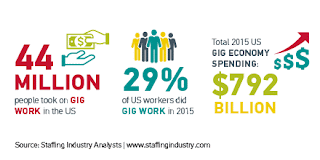The “gig economy” has firmly entered employment vocabulary, becoming a catch-all term for anything from Uber taxi drivers to freelance professionals. But what does this hyper-flexible way of working mean for HR?
What is the Gig Economy?
For some, it simply refers to the ever-growing number of people who use one of the (still relatively) new talent platforms or online service brokering like Uber, Airbnb, Upwork, TaskRabbit.
For others, it includes these people, but also anyone who works in a contingent, temporary, diversified or freelance capacity. In other words, anyone who isn’t a full-time or part-time employee.
(Revelian.com)
How big is it?
The lack of clarity about what it actually comprises leads, not surprisingly, to ambiguity about how big it actually is – that is, what percentage of the workforce it involves.
If we start at the smaller end of the scale – people earning income via online platforms, then it’s certainly increasing at a rapid rate.
This recent study from JPMorgan Chase Institute found that 1% of all US workers are involved in one or more of these online platforms, which equates to the number of people working in the US public school system.
A late 2015 Time study that include all kinds of contingent workers, rather than just platform workers, have claimed that 44% of all US workers are involved in non-traditional employment
In Australia, Jim Minifie of the Gratton Institute found that “Platforms such as Airtasker and Expert360 had not changed the shape of the labour market, with independent contractors steady at about 9 per cent of the workforce for the past 15 years and workers using digital peer-to-peer platforms numbering only about 80,000 in a labour force of 11 million.”
When you take the gig economy at face-value, it seems to be one of the most desirable forms of employment, with employees seemingly gaining freedom to work the hours they wish, often in a quirky office, and for an innovative, forward-thinking company. (Griffiths , 2017)
In a Nutshell
On one level, the rising shared economy simply means more options and a broader horizon for employees. Increasingly, the market supports freelance and contract employees who join the on-demand market by choice rather than in response to crisis or the loss of a traditional job. Gone are the days when "self-employed" was a thinly veiled term for unemployment. Increasingly, freelance work and self-employment are associated with greater freedom, flexibility, options, new possibilities, and a safety cushion.
Benefits :
- Flexibility
For employees, flexibility is one of the biggest draws of on-demand work. The availability and prevalence of freelance opportunities at the tips of employees' fingers reveals options in flexibility that a few years ago were minimal in middle America. It's now possible to work from home while supporting younger children, pursue a passion project part time while bringing in enough cash to pay the bills, and take as much time off to travel as a given situation allows.
- Options
With low barriers to entry and endless opportunities for freelance employment (and more popping up daily) literally at their fingertips, employees' biggest hurdles to joining the on-demand workforce is often determining which freelance employment opportunities are the best fit for their lifestyle, skillset, and time.
- Safety Cushions
Gone are the days of a mad scramble to find a job-any job-if traditional employment falls through. Now employees have higher quality, varied options for stop-gap employment (that may well turn into a long-term situation by choice for many). Rising options for on-demand, gig-style employment can take some of the stress out of job searching, by giving employees a sustainable cushion of income and allowing them to take their time finding the best fit for new employment.
Risks and Challenges
- Inconsistent Income
The benefit of on-demand platforms that support low barriers to entry comes with an inherent drawback for employees: low barriers to exit. Any given source of contract work can dry up quickly, in some cases because of negative reviews of a freelancer's performance (especially reviews that are publically available, in apps like Uber and Airbnb), and most sources of freelance work depend on the sometimes arbitrary satisfaction of a client.
- New Costs
Contractors may find that costs like health insurance and other work-related expenses have a significant impact on their net take-home pay
- Fewer Protections
Contract work typically means that most of the safeguards available to W-2 employees are absent in the on-demand dynamic. Severance pay, disability leave, PTO, sick days, and workers comp are just a few of the protections and benefits afforded to full- and part-time employees but not contractors. It's also far easier for employers to terminate a relationship with a freelancer as opposed to a full- or part-time employee.
References:
Revelian.com, 2017 , Grasping Smoke: Defining the Gig Economy and its HR Implications ,http://www.revelian.com/blog/grasping-smoke-defining-the-gig-economy-and-its-hr-implications/, Accessed 08.10 am, 2018.07.05
TSheets.com, 2017 ,What Is The Gig Economy-And How Does It Impact Employees? https://www.tsheets.com/resources/gig-economy-employees , Accessed on 08.50 am, 2018.07.05
Griffiths C, 2017, Do HR and the Gig Economy Have a Future? , http://www.onrec.com/news/news-archive/do-hr-and-the-gig-economy-have-a-future, Accessed on 9.10 a.m. 2018.07.05
Everett C. , 2016, Do HR and the Gig Economy Have a Future ,https://www.personneltoday.com/hr/gig-economy-what-it-means-for-hr/, Accessed on 09.40 a.m, 2018.07.05





comprehensive article . keep the momentum
ReplyDeleteVery interesting topic and we written content. Good Luck!
ReplyDeleteEssay with a rich content. Keep up the good work.
ReplyDeleteWell structured article,
ReplyDeleteplease check the references
Good article with descriptive journal articles. keep it up
ReplyDeleteGood essay, with nice flow of contents
ReplyDeleteWell executed essay with a nice flow.
ReplyDelete